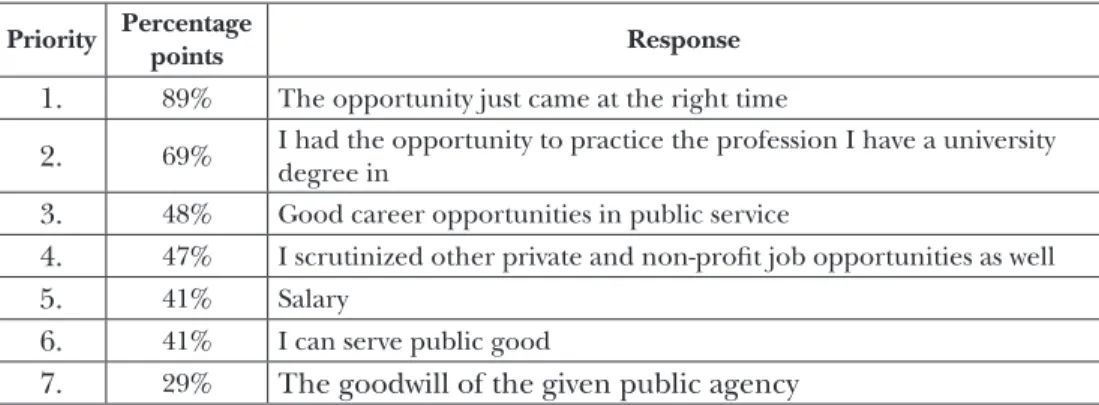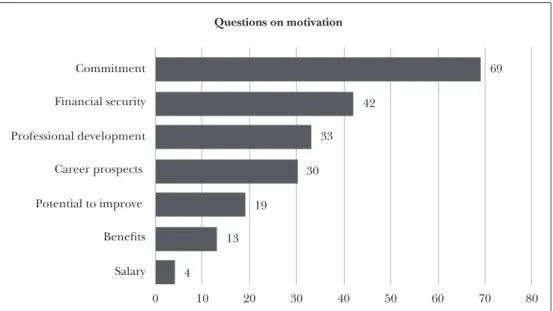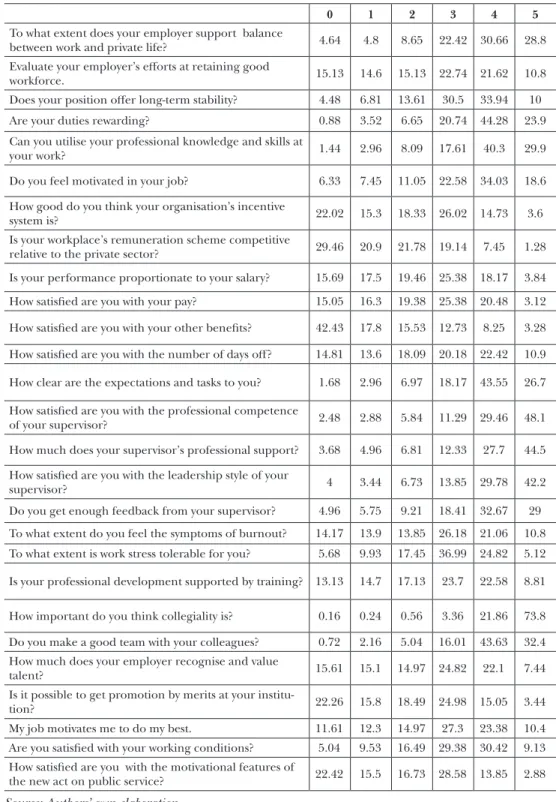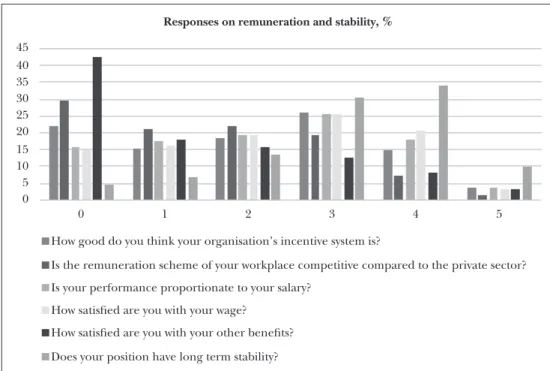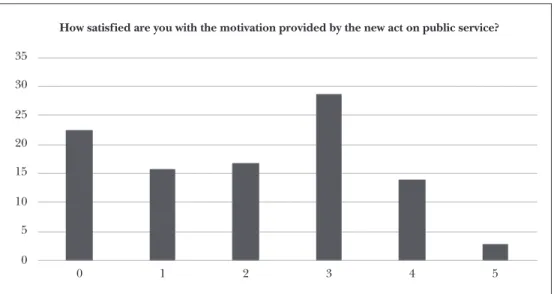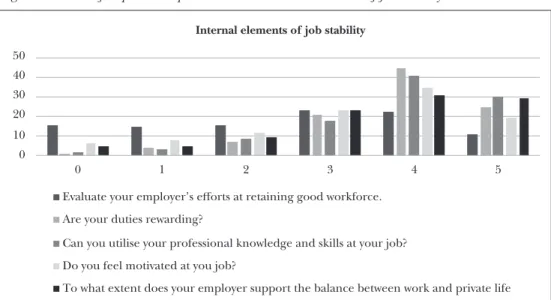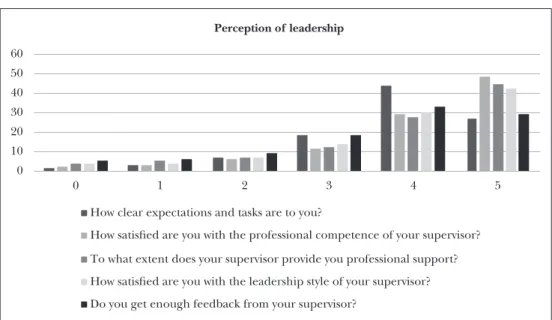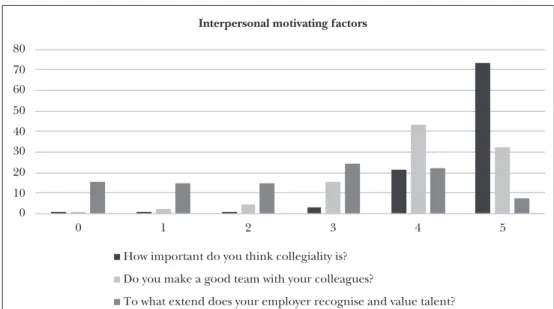Márton Gellén, Anita Mária Rácz
Motivation and Professionalisation in Hungarian Civil Service
– an Empirical Analysis on Hungarian Regional Civil Service
Summary
The article displays and analyses the re- sults of empirical research, in the context of mainstream public sector motivation PSM literature, and in the context of the recent Hungarian legislation on public service personnel management. The aim of the article is to clarify the impact of the new legislation on the motivation of Hun- garian civil servants. The findings ought to be interpreted with references to the com- plexities of practice in Central and Eastern European civil service, widely considered as Weberian, although with significant ele- ments of legalism, politicisation and post- Soviet management style. As this public ad- ministration culture is heterogeneous and its components are contradicting, changes in public personnel management policies might lead to unexpected or largely vary-
ing effects. This article presents the find- ings of public personnel management policy change through the evaluation of the responses of civil servants in regional civil service. The article concludes that the subjective value of job security is less than expected, but satisfaction with the pay is significantly above expected. Streams for promotion are frozen, good workforce is difficult to retain in civil service but those who remain in the service consider them- selves highly motivated, receiving helpful support from their supervisors and feeling that they have a rewarding job in serving the public.
Journal of Economic Literature (JEL) codes:
H83, J45, O18
Keywords: public sector motivation, leader- ship, public administration culture
Márton Gellén PhD, university lecturer, National University of Public Service, Budapest; Anita Mária Rácz, PhD student, National University of Public Service, Budapest1
Public Service Motivation theory in brief
Public Service Motivation (PSM) theory was, for the most part, developed by James Perry, who separated motivation, as a certain pas- sion of serving the public, and the general management motivation theory, which was created to meet the needs of the business sector. The main finding of the PSM theory is that staff motivation in the public sector is characterised by significantly different fea- tures than motivation in the private sector.
Civil servants indeed have very different in- ternal preferences than workers in the mar- ket sector. Furthermore, certain motivating factors that are applicable in the business sector prove to be even counter-productive when it comes to the public sector.
Perry et al. (2006) found that financial incentives slightly influence work perfor- mance in the public sector but far from being as effective as one would instinctively think. In fact, changing the way of thinking about the effect of financial incentives in the public sector was one of the main intel- lectual achievements of PSM theory. Stajko- vic and Luthans (2003) based their findings on an empirical research of 72 cases, and concluded that financial incentives have 23 per cent impact on work performance while social recognition correlated to work per- formance by 17 per cent and feedback from the supervisor contributed to work perfor- mance by 10 per cent. Any single one of these factors hardly improved performance but if conducted in a combined way, their overall impact was 45 per cent, which can be considered as a significant and tangible performance growth. Bucklin and Dickin- son (2001) found that individual financial incentives – such as pay by performance – do have beneficial impact on individual
motivation but such incentives are more ef- fective if they are applied in combination with feedbacks from supervisors. Perry et al. (2006), however, insist that this finding was based on research that has a rather low validity in relation to public service.
According to the studies of Milkovich and Wigdor (1991) pays based on perfor- mance do have a tangible impact but only if the remuneration policy is embedded into a fair and effective process. The actual fea- sibility and comprehensibility of the prac- tice followed by any given public institution is almost as important as the potential pay itself.
Contrary to the theorists of public ser- vice motivation directed to increase indi- vidual performance, Perry et al. (2006) found that group incentives are more ef- ficient than individual motivators. In con- tent, group incentive means that a certain percentage of the pay is tied to the collec- tive performance of a given group, unit of sub-unit. Perry et al. (2006) base this state- ment on the results of DeMatteo, Eby and Sundstrom (1998) as well as on Honeywell- Johnson and Dickinson (1999).
Naturally, there were substantial differ- ences between the research designs listed above but the authors have consensus in concluding that equally distributed, rela- tively small groups were the most receptive to group incentives.
Work schedule, planning and the or- ganisation of work also strongly correlate with motivation. At this point affective and behavioural motivations need to be differ- entiated based on the works of Griffin et al.
(1981). Perry et al. (2006) agree with Griffin et al. (1981) that measuring work results is much more difficult than measuring work- ers’ satisfaction, while these two factors do not necessarily correspond to each other.
Civil servants’ participation in decision- making is anothre important element in pub- lic-sector motivation according to Cawley et al. (1998).Gellén (2016) detected a strong desire among civil servants for involvement in public sector decisions. According to Wagner (1994), participation may contrib- ute to better decisions but its causal connec- tion to motivation is limited. Participation is linked to leadership by objectives, which was among the most intensively researched fields in the USA in the 1990’s (Mitchell and Daniels, 2003). Setting objectives and motivating personnel towards objectives proved to be difficult a task due to multiple contextual elements that influenced motiva- tion. If objectives are too abstract or too dif- ficult to comprehend, it tends to discourage civil servants and thus often diminishes their motivation (Locke and Latham, 2002). Ac- cording to Perry et al. (2006), motivation by objectives provides tangible results if the ob- jectives are matched by feedbacks and per- formance-based remuneration. Desmarais and Gamassou (2014) question the gener- ally assumed high correlation between PSM and hierarchic position. They found that relatively high PSM can be measured even at the lower ranks of the (French) civil service.
They explain their finding by an a priori ex- isting altruistic mind-set in civil servants and by the cultural specificity of Francophone countries that civil servants feel rewarded by being able to do something for the public (Cartier et al., 2010).
The correlation between PSM and age (Bright, 2005) and PSM and position in the hierarchy are also discussed by various authors. Naff and Crum (1999) found that PSM slightly increases throughout the long years of the public service career. Perry (1997) also demonstrates this phenom- enon and explains it by assuming that there
is a higher probability of occupying leader- ship positions at a higher age, furthermore, merit-based promotion systems tend to select those to higher positions who have high motivation in general.
According to the PSM theory it is an improper approach to assume that general management techniques can be automati- cally implemented in the public sector. Ap- preciation and “the ability to do something for others”, similarly to “being involved in important things” (Gellén and Kudo, 2015) are nearly as important motivating factors as an appropriate pay.
The motivation to choose a public sec- tor job largely stems from the trust that such jobs are more stable than those of- fered in the private sector. This percep- tion is, however, increasingly less accepted, and therefore lifelong loyalty and commit- ment are less typical than they used to be (Bozeman and Ponomariov, 2009). Köllő indicates that relative pay position is the decisive factor to encourage cross-sector mobility (Köllő, 2013). Another chunk of theory has its focus on more subtle factors, which are difficult to detect, such as the principal–employee relationships (Jurkie- wicz and Brown, 1998). Instead of search- ing for a single factor of motivation in cross- sector mobility, Ito conducted his research in three clusters of public service, including technical, professional and leadership po- sitions (Ito, 2003). He focused on motiva- tions to apply for a public sector position.
According to his findings – based on a sam- ple of 310 Canadian federal administrators – the key motivating factors see in Table 1.
According to Ito’s findings (2003), in the case of Canadian civil servants, commit- ment to the common good or to the agency are not among the top priorities of choos- ing a public service career.
Table 1: Jack Ito’s numeric results on the motivational factors in Canadian civil service, 2003 Priority Percentage
points Response
1. 89% The opportunity just came at the right time
2. 69% I had the opportunity to practice the profession I have a university degree in
3. 48% Good career opportunities in public service
4. 47% I scrutinized other private and non-profit job opportunities as well
5. 41% Salary
6. 41% I can serve public good
7. 29% The goodwill of the given public agency Source: Authors’ own elaboration
Empirical findings on motivation in Hungarian civil service
Hungary is generally considered as part of the Weberian public administration culture. It is also said to be highly legalis- tic (see Hintea et al., 2006; Hajnal, 2014), while having tendencies towards politicisa- tion (Meyer-Sahling, 2006). Cameron and Orenstein (2012) add the perspective of the near past, claiming that a certain fla- vour of post-Soviet leadership style is also present in the public sectors of the entire region. Out of the layers of complexities, we consider the Weberian aspect to be the most profound and decisive. Empirical findings on motivation ought to be inter- preted taking Weberian legacy as a contex- tual element.
Empirical research on PSM in Hun- garian civil service is not as abundant as it could or should be. Characteristic find- ings made back in 2016 serve as points of reference to the recent empirical research described in the following part of this arti- cle (Gellén, 2016). One might argue that there were substantial differences between the data collection methods of the two re- search projects, the former conducted in
2014 and the latter in 2019. Such remarks are valid. Still, both research projects were conducted mostly in regional civil service, namely in the ranks of County Government Offices, and both were focussed (in the for- mer case partly) on motivational character- istics in Hungarian civil service.
Figure 1 displays the numerical results of the research on motivating factors in Hungarian civil service.
The original questionnaire was com- piled in a way that responses shed light on the reason for choosing a public sector job.
According to the 2016 article, respondents (10,004 in total) almost equivocally denied that their motivation was based on their salary or on other benefits. On the other hand, intrinsic motivating factors, such as commitment, were rated relatively high.
Rácz collected empirical data at four public administration authorities in the sec- ond half of 2019. She approached 31 pub- lic administration institutions by electronic questionnaires during the research (sup- plemented by personal phone calls), how- ever, only four of them agreed to engage in the proposed empirical research. One of the letters of rejection from a public admin- istration explained their refraining from
Figure 1: Findings related to motivation in Gellén, 2016
4 13
19
30 33
42
69
0 10 20 30 40 50 60 70 80
Salary Benefits Potential to improve
Career prospects Professional development
Financial security Commitment
Questions on motivation
Note: Figures show responses on a Likert scale of 1-5, extrapolated to a 0-100 interval.
Source: Authors’ own elaboration
the research by the 2018 Act on Public Sector Staff (Kit.), which cast heavy work- load on the civil and public servants, and thus, unfortunately, they had insufficient time and resources to participate in other activities beyond their regular office work.
In fact, Rácz’s research was conducted at a time when the new act redesigned the land- scape of the central and regional public administration in terms of human resource management.
Out of the four respondent authorities, three were County Government Offices and one was an autonomous public admin- istration agency.
As anonymity was guaranteed to the re- spondents, the public administration insti- tutions involved in the research are marked by numbers. One of the strengths of the research was that the respondents included civil servants in both executive and non- executive positions.
The total sample contained 1249 re- spondents, including:
– 404 respondents from Authority 1, – 513 respondents from Authority 2, – 305 respondents from Authority 3 and – 27 respondents from Authority 4.
The composition of the sample regard- ing executive positions was the following:
– Top leaders: 16 respondents,
– Directors, heads of divisions, heads of units: 139 respondents,
– Civil servants: 1084 respondents, – Physical staff: 10 respondents.
The respondents had the opportunity to rate questions on a 6-degree Likert-scale (from 0 to 5) indicating 0 as total negation and 5 as total affirmation. The question- naire contained 38 questions, which sug- gests a fairly thorough analysis. The Table 2 gives an overview of the responses analysed in more detail.
Table 2: Summary of numeric results of Rácz’s survey on civil service motivation, 2019
0 1 2 3 4 5
To what extent does your employer support balance
between work and private life? 4.64 4.8 8.65 22.42 30.66 28.8
Evaluate your employer’s efforts at retaining good
workforce. 15.13 14.6 15.13 22.74 21.62 10.8
Does your position offer long-term stability? 4.48 6.81 13.61 30.5 33.94 10
Are your duties rewarding? 0.88 3.52 6.65 20.74 44.28 23.9
Can you utilise your professional knowledge and skills at
your work? 1.44 2.96 8.09 17.61 40.3 29.9
Do you feel motivated in your job? 6.33 7.45 11.05 22.58 34.03 18.6 How good do you think your organisation’s incentive
system is? 22.02 15.3 18.33 26.02 14.73 3.6
Is your workplace’s remuneration scheme competitive
relative to the private sector? 29.46 20.9 21.78 19.14 7.45 1.28 Is your performance proportionate to your salary? 15.69 17.5 19.46 25.38 18.17 3.84 How satisfied are you with your pay? 15.05 16.3 19.38 25.38 20.48 3.12 How satisfied are you with your other benefits? 42.43 17.8 15.53 12.73 8.25 3.28 How satisfied are you with the number of days off? 14.81 13.6 18.09 20.18 22.42 10.9 How clear are the expectations and tasks to you? 1.68 2.96 6.97 18.17 43.55 26.7 How satisfied are you with the professional competence
of your supervisor? 2.48 2.88 5.84 11.29 29.46 48.1
How much does your supervisor’s professional support? 3.68 4.96 6.81 12.33 27.7 44.5 How satisfied are you with the leadership style of your
supervisor? 4 3.44 6.73 13.85 29.78 42.2
Do you get enough feedback from your supervisor? 4.96 5.75 9.21 18.41 32.67 29 To what extent do you feel the symptoms of burnout? 14.17 13.9 13.85 26.18 21.06 10.8 To what extent is work stress tolerable for you? 5.68 9.93 17.45 36.99 24.82 5.12 Is your professional development supported by training? 13.13 14.7 17.13 23.7 22.58 8.81 How important do you think collegiality is? 0.16 0.24 0.56 3.36 21.86 73.8 Do you make a good team with your colleagues? 0.72 2.16 5.04 16.01 43.63 32.4 How much does your employer recognise and value
talent? 15.61 15.1 14.97 24.82 22.1 7.44
Is it possible to get promotion by merits at your institu-
tion? 22.26 15.8 18.49 24.98 15.05 3.44
My job motivates me to do my best. 11.61 12.3 14.97 27.3 23.38 10.4 Are you satisfied with your working conditions? 5.04 9.53 16.49 29.38 30.42 9.13 How satisfied are you with the motivational features of
the new act on public service? 22.42 15.5 16.73 28.58 13.85 2.88 Source: Authors’ own elaboration
In the columns of the table the ratios of the respondents choosing the given weight of preference to the total number of respondents are specified. In each col- umn the expected ratio is 16.66, indicating that one-sixth of the respondents prefer each answer at a particular weight. There are significant extremes both upstream and downstream, and this requires additional explanation.
In order to establish correlation with the briefly indicated PSM theory, the following groups of questions are further scrutinised.
First, the results are analysed according to traditional, external motivating factors, namely pay and job security, and then in- ternal motivational elements are analysed (Figure 4). Leadership and interpersonal motivating factors are displayed in Figure 5 and Figure 6.
Analysis of the 2019 empirical findings
Figure 2 shows the aggregate distributions for the response ratios in a breakdown of questions. Being not overtly satisfied with one’s pay is generally normal; therefore the top pay satisfaction category has relatively low support.
Figure 2 allows two characteristic re- marks. Primarily, it is apparent that “other benefits” are frustrating rather than re- warding or comforting, let alone motivat- ing. “Other benefits” include the following:
– Contribution to rental fees or to the purchase or construction of a new flat or house,
– Support to young families, – Social benefit,
– Prepayment on the salary, Figure 2: Response ratios, remuneration and job stability in Rácz’s 2019 empirical research
0 5 10 15 20 25 30 35 40 45
0 1 2 3 4 5
Responses on remuneration and stability, %
How good do you think your organisation’s incentive system is?
Is the remuneration scheme of your workplace competitive compared to the private sector?
Is your performance proportionate to your salary?
How satisfied are you with your wage?
How satisfied are you with your other benefits?
Does your position have long term stability?
Source: Authors’ own elaboration
– Scholarship, contribution to profes- sional training or to learning a foreign lan- guage,
– Holiday benefit.
It is characteristically recognisable that job stability is still highly appreciated com- pared to other motivating factors. Legal provisions regulating job stability in civil service have undergone significant chang- es with the adoption of Kit. in 2018. The merit-based – or at least long-term loyalty- based – promotion system has been a de- cisive characteristic of Hungarian public personnel policy since the early 1990’s, when labour law, the act on public service and the act on civil service were adopted.
In 2018 (with effect from 1 January, 2019) the previous system of rewarding long-term loyalty with higher salary was replaced by a fixed position system. The overall percep- tion of motivation by the new act is shown in Figure 3.
Figure 3 shows a split between moderate dissatisfaction (3) and strong dissatisfaction
(0) with the motivating features of the 2019 act on public service, after a quarter of a year following its entry into force.
Under the new conditions, a new candi- date enters civil service in a given position, he or she remains there until there is an opportunity to take someone else’s higher position. Automatic or at least prospective promotion is excluded. Pay rises may be given within the financial framework of the given category. When a civil servant reaches the top position in his or her employment category, there are no further career per- spectives ahead. This may be considered as an up or out system in civil service, which is characteristically contrary to the existing and culturally embedded Weberian bureau- cratic culture. Despite this legal context, re- spondents were not concerned about their job stability.
Public sector salaries are apparently seen as moderate but balanced. This how- ever, should be considered a great leap forward compared to the previous research Figure 3: Scores of the motivation by the new act on public service (Kit.)
0 5 10 15 20 25 30 35
0 1 2 3 4 5
How satisfied are you with the motivation provided by the new act on public service?
Source: Authors’ own elaboration
Figure 4: Ratios of responses to questions on the internal elements of job stability
0 10 20 30 40 50
0 1 2 3 4 5
Internal elements of job stability
Evaluate your employer’s efforts at retaining good workforce.
Are your duties rewarding?
Can you utilise your professional knowledge and skills at your job?
Do you feel motivated at you job?
To what extent does your employer support the balance between work and private life Source: Authors’ own elaboration
(Gellén, 2016) cited above. Actually, sig- nificant efforts have been made to increase pays in civil service simultaneously with new legislation on employment: pay hikes added up to 30 per cent on average, and must have had a beneficial effect on the re- spondents’ perception. On the other hand, comparison with market wages reflects the common perception in the Hungarian public sector that market jobs are paid con- siderably better than public sector jobs, al- though factually this is not necessarily true.
Figure 4 shows the distribution of the ra- tios of the internal elements of job satisfac- tion. Employers’ efforts – and probably abil- ity – to retain good workforce are relatively ambiguous, with a dominantly even distri- bution, while the content of public jobs ap- pears to be outstandingly positive (duties are rewarding). Reliance on professional skills, the feeling of self-motivation, and balance between work and private life ap- pear to be characteristically granted. These elements have significantly improved com-
pared to Gellén (2016), whereas commit- ment was characteristically admitted, but all the other factors, such as career prospects, professional development and potential to improve were predominantly perceived by the respondents as non-existent.
Figure 5 displays the ratios of the re- sponses to questions on leadership. Inter- estingly, the picture is outstandingly posi- tive. At this point (especially regarding the question on supervisor’ leadership style), it appears to be legitimate to think of a con- trol bias.
Supervisors’ professional competence was also rated outstandingly high. In this case, control bias is even more complex to untangle than with the direct question on the supervisor’s leadership style. One of the remarkable results of Gellén’s (2016) research was that the Weberian public ad- ministration culture embraces professional competence and almost instinctively relates it to leadership and vice versa. According to this bureaucratic mind-set, one is selected
Figure 5: Distribution of responses to questions on leadership
0 10 20 30 40 50 60
0 1 2 3 4 5
Perception of leadership
How clear expectations and tasks are to you?
How satisfied are you with the professional competence of your supervisor?
To what extent does your supervisor provide you professional support?
How satisfied are you with the leadership style of your supervisor?
Do you get enough feedback from your supervisor?
Source: Authors’ own elaboration
to act as a leader because of his or her pro- fessional competence. Leadership position places the leader in an aura of competence even if professional competence is objec- tively untrue. This cultural setting matches the directive leadership style (Van Wart et al., 2015) that is fairly exhibited by high scores assigned to the “professional compe- tence of the leader”, “professional support”
and “feedback from supervisor”. If these factors are so highly appreciated by the re- spondents then how is it possible that the public institutions of the respondents tend not to be able to retain good workforce? It is a legitimate assumption that good work- force is incompatible with directive lead- ership style, which cannot flourish in the midst of excellent workforce.
Interpersonal motivating factors are somewhat different in Hungary than those described by Perry et al. (2006) as collective incentives in the United States. The estab- lishment of collective incentive schemes by
splitting the amount of salary to private and collective portions is unknown in Hungar- ian civil service. Instead, collective motiva- tion factors are rather related to the subjec- tive value of belonging to a community that shares the same commitment to serving the public or to a given group of clients.
There are two dimensions in interper- sonal motivating factors: one relates to horizontal interpersonal relations, namely collegial, peer to peer, intra-unit or intra- organisation relationships, and the other connects the civil servant to upstream super- visors or managers. Figure 6 plots both di- mensions. Most remarkably, collegiality as an abstract value scored 73.8 per cent, far more than any other figure in this research. Hun- garian civil servants appreciate peer to peer solidarity and collective experience. Interest- ingly, when it comes to action, their enthu- siasm substantially fades. Making an actual good team with colleagues is considerably less supported than the abstract idea of col-
Figure 6: Ratios of responses to questions on interpersonal motivating factors
0 10 20 30 40 50 60 70 80
0 1 2 3 4 5
Interpersonal motivating factors
How important do you think collegiality is?
Do you make a good team with your colleagues?
To what extend does your employer recognise and value talent?
Source: Authors’ own elaboration
legiality, although support to making a good team still scores very high compared to the other results in this research. This correla- tion reveals the two parallel realms of desires and actual experience. The question about the importance of collegiality as a general, abstract concept may instinctively spike pleasant emotions, while directing the re- spondent to the actual group around him or her might raise doubts in the respondent.
Recognising and valuing talent is an im- portant interpersonal leadership skill, but this factor does not enjoy unequivocal sup- port. In fact, affirmation for this motivating factor is rather ambiguous. How come that the respondents who have previously stated that they are motivated and receive good professional support from their supervisors are so unconfident concerning talent recog- nition and support from their employers? In our assumption, the answer to this question may be traced back to the previously men- tioned directive leadership style that creates
the image of a highly competent leader but fails to involve competence and talent from the subordinate civil servants.
Conclusions
The article has verified much of the general PSM theory but in a different social, cultur- al and institutional context. According to the current research, slight changes have taken place in the internal characteristics of the Hungarian civil service PSM, which may be attributed to the recent changes in the legislation regulating human resources management in the public sector.
There is a significant improvement in pay satisfaction compared to Gellén (2016).
This appears to be obvious, as pays have actu- ally been increased. On the other hand, cer- tain desperation is detectable in civil service ranks, suggested by the limited ability of civil servants to have their talent recognised and appreciated, since the prospect of working
well and staying in service for a long time, gaining increasing appreciation over time and loyalty is excluded. The internal chan- nels of “organic” development have become limited. Paradoxically, this enhances their hierarchical relationship with their supervi- sors and enhances the image of the profes- sionally competent, directive leader. What we claim is not that leaders should not be professionally competent. On the contrary.
Still, there is much more potential in main- taining motivation in civil service by allowing them feel that they can gain recognition and establish solid careers if they cherish the am- bition of their individual development.
The message of collegiality should be taken seriously. The unprecedented high support to collegiality reveals that Hungar- ian civil servants are beyond the social psy- chological level of solely individual public endeavours. The research has shown that it is time to endeavour to find collective organisational solutions that would enable the operation of civil service units at a high- er level of internal autonomy.
Notes
1 Anita Mária Rácz is a PhD student at the Doc- toral School of Public Administration at the National University of Public Service (NUPS), Budapest. She also works as a HR officer at the Office of Education in Central Budapest, a pub- lic institution employing 1,500 people. Assistant professor Márton Gellén is her PhD supervi- sor at NUPS, and a visiting associate professor at Kwansei Gakuin University, Japan, who also served as deputy state secretary for victim sup- port and legal aid.
References
Bozeman, B. and Ponomariov, B. (2009): Sector Switching from a Business to a Government Job: Fast-Track Career or Fast Track to No- where? Public Administration Review, Vol. 69,
No. 1, pp. 77–91, https://doi.org/10.1111/
j.1540-6210.2008.01942.x.
Bright, L. (2005): Public Employees with High Level of Public Service Motivation: Who Are They, Where Are They, and What Do They Want? Review of Public Personnel Administra- tion, Vol. 25, No. 2, 138–154, https://doi.
org/10.1177/0734371x04272360.
Bucklin, B. R. and Dickinson, A. M. (2001): Individ- ual Monetary Incentives: A Review of Different Types of Arrangements between Performance and Pay. Journal of Organisational Behavior Man- agement, Vol. 21, No. 3, 45–137, https://doi.
org/10.1300/j075v21n03_03.
Cameron, D. R. and Orenstein, M. A. (2012): Post- Soviet Authoritarianism: The Influence of Rus- sia in Its “Near Abroad”. Post-Soviet Affairs, Vol.
28, No. 1, 1–44, https://doi.org/10.2747/1060- 586X.28.1.1.
Cartier, M.; Retière, J.-N. and Siblot, Y. (2010):
Le salariat a` statut. Presses Universitaires de Rennes, Rennes.
Cawley, B. D.; Keeping, L. M. and Levy, P. E. (1998):
Participation in the Performance Appraisal Pro- cess and Employee Reactions: A Meta-Analytic Review of Field Investigations. Journal of Applied Psychology, Vol. 83, No. 4, 615–633, https://doi.
org/10.1037/0021-9010.83.4.615.
DeMatteo, J. S.; Eby, L. T. and Sundstrom, E.
(1998): Team-Based Rewards: Current Em- pirical Evidence and Directions for Future Re- search. Research in Organisational Behavior, Vol.
20, 141–183.
Desmarais, C. and Gamassou, C. E. (2014): All Mo- tivated by Public Service? The Links between Hierarchical Position and Public Service Mo- tivation. International Review of Administrative Sciences, Vol. 80, No. 1, 131–150, https://doi.
org/10.1177/0020852313509553.
Gellén, M. and Kudo, H. (2015): What Individual Career Strategies Teach Us About Public Administra- tion: A Comparative Study of Japan and Hungary.
Conference paper, IRSPM Annual Conference, Birmingham, www.researchgate.net/publica- tion/301684021_IRSPM_2015_Paper_with_pro- fessor_Hiroko_Kudo.
Gellén, M. (2016): Potentials for Horizontal Coop- eration in a Centralized Setting: Empirical Re- search on Hungarian Civil Servants’ Perceptions on Public Administration Culture. Transylvanian Review of Administrative Sciences, No. 37, 37–53.
Griffin, R. W.; Welsh, A. and Moorhead, G. (1981):
Perceived Task Characteristics and Employee Performance: A Literature Review. Academy of Management Review, Vol. 6, No. 4, 655–664, https://doi.org/10.2307/257645.
Hajnal, Gy. (2014): Public Administration Educa- tion in Europe: Continuity or Reorientation?
Teaching Public Administration, 11 June, https://
doi.org/10.1177/0144739414538043.
Hintea, C.; Ringsmuth, D. and Mora, C. (2006):
The Reform of the Higher Education Public Administration Programs in the Context of Pub- lic Administration Reform in Romania. Transyl- vanian Review of Administrative Sciences, No. 16, 40–46.
Honeywell-Johnson, J. A. and Dickinson, A. M.
(1999): Small Group Incentives: A Review of the Literature. Journal of Organisational Behavior Management, Vol. 19, No. 2, 89–120, https://doi.
org/10.1300/J075v19n02_06.
Ito, J. K. (2003): Career Mobility and Branding in Civil Service: An Empirical Study. Public Person- nel Management, Vol. 32, No. 1, 1–21, https://
doi.org/10.1177/009102600303200101.
Jurkiewicz, C. L. and Brown, R. G. (1998): GenX- ers vs. Boomer bs. Matures: Generational Com- parisons of Public Employee Motivation. Review of Public Personnel Administation, Vol. 18, No. 4, 18–37.
Köllő, J. (2013): A közszféra bérszintje és a magán- szektorból átlépők szelekciója 1997-2008 között [Wage level in the public sector and the selec- tion of people transferred from the private sec- tor between 1997 and 2008]. Közgazdasági Szemle, Vol. 60, No. 5, 523–554.
Locke, E. A. and Latham, G. P. (2002): Building a Practically Useful Theory of Goal Setting and Task Motivation: A 35-Year Odyssey. American Psychologist, Vol. 57, No. 9, 705–717, https://doi.
org/10.1037/0003-066x.57.9.705.
Meyer-Sahling, J.-H. (2006): The Institutionalisa- tion of Political Discretion in Post-Communist Civil Service Systems: the Case of Hungary. Public Administration, Vol. 84, No. 3, 693–715, https://
doi.org/10.1111/j.1467-9299.2006.00608.x.
Milkovich, G. T. and Wigdor, A. K. (eds.) (1991): Pay for Performance. Evaluating Performance Appraisal and Merit Pay. National Academy Press, Washing- ton, https://doi.org/10.5860/choice.29-2194.
Mitchell, T. R. and Daniels, D. (2003): Motivation.
In: Borman, W. C.; Ilgen, D. R. and Klimoski, R.
J. (eds.): Handbook of Psychology. Industrial and Organisational Psychology. Wiley Publisher, New York, 225–254.
Naff, K. C. and Crum, J. (1999): Working for Amer- ica: Does Public Service Motivation Make a Dif- ference? Review of Public Personnel Administration, Vol. 19, No. 4, 5–16, https://doi.org/10.1177/0 734371x9901900402.
Perry, J. L. (1997): The Antecedents of Public Ser- vice Motivation. Journal of Public Administration Research and Theory, Vol. 7, No. 2, pp. 181–197, https://doi.org/10.1093/oxfordjournals.jpart.
a024345.
Perry, J. L.; Mesch, D. and Paalberg, L. (2006): Moti- vating Employees in a New Governance Era: The Performance Paradigm Revisited. Public Adminis- tration Review, Vol. 66, No. 4, 505–514, https://
doi.org/10.1111/j.1540-6210.2006.00611.x.
Stajkovic, A. and Luthans, F. (2003): Behavioral Management and Task Performance in Organi- zations: Conceptual Background, Meta-Analysis, and Test of Alternative Models. Personnel Psy- chology, Vol. 56, No. 1, 155–194, https://doi.
org/10.1111/J.1744-6570.2003.TB00147.X.
Stajkovic, A. D. and Luthans, F. (2006): Behavioral Management and Task Performance in Organi- sations: Conceptual Background, Meta-Analysis, and Test of Alternative Models. Personnel Psy- chology, Vol. 56, No. 1, 155–194, https://doi.
org/10.1111/j.1744-6570.2003.tb00147.x.
Van Wart, M.; Hondeghem, A.; Schwella, E. and Nice, V. E. (eds.) (2015): Leadership and Culture.
Comparative Models of Top Civil Servant Training.
Palgrave, Hampshire.
Wagner, J. A. (1994): Participation’s Effects on Per- formance and Satisfaction: A Reconsideration of Research Evidence. Academy of Management Review, Vol. 19, No. 2, 312–330, https://doi.
org/10.2307/258707.
